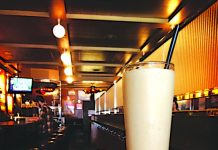
Michigan’s increasingly popular craft-beer movement has a sweet aftertaste. Boutique brewing is opening doors to other locally made products — hard cider among them.

“It’s fortunate for us that the craft-brewing industry is doing so well,” says Paul Vander Heide, who began producing hard cider in 2008 at his Vander Mill in Spring Lake, Mich. “It’s really helping push the consumer to try different things.”
Mike Beck, owner of Uncle John’s Cider Mill in St. Johns, near Lansing, says hard ciders are attractive as an alternative to beer and wine.
“There are a growing number of people with celiac disease [who can’t drink beer],” Beck says (pictured below next to one of the steel fermentation tanks). “They want to have a more beer-like experience and wine doesn’t do the job for them; there’s no pop or fizz to it.”
Much like beer, ciders can range in alcohol content from 2 to 9 percent. They also can be fortified with distilled spirits or aged in bourbon barrels, which will boost their alcohol content.
Beck has been making hard cider since 2001 and has witnessed how rapidly the industry has grown. “It has been growing 25 percent per year ever since,” he says. “Now the national sales are starting to match local sales … hard cider is catching on nationwide.”
Until recently, what most people thought of as hard cider came from major multi-national producers, such as Woodchuck and Strongbow, who turn out sweet, mass-produced factory ciders made from apple-juice concentrate. Most cider makers say these producers have been a bit of a double-edged sword for craft producers, raising awareness to the product but giving people the entirely wrong impression. “The most important thing is that Michigan craft producers are using Michigan fruit and they’re pressing and fermenting real cider,” Vander Heide says. “It’s not a concentrate game like it is for the big guys.”

Dan Young, who, with his wife, owns Tandem Ciders in Northern Michigan’s Suttons Bay, says they try to let their “ciders be an expression of [the particular] apple, whether it’s dry, like our Farmhouse cider, or like Smackintosh, [in] which we leave a lot of residual sugar behind … we’re just trying to get an expression of that fruit.” The Smackintosh, which is Tandem’s most popular, is made primarily from common McIntosh apples and is lush and subtly sweet, like the fruit itself.
Although ciders can be aged in oak barrels, fermentation is done in steel tanks. The liquid needs to be fermented with yeast in a sterile environment so it won’t turn into cider vinegar. From apples to store shelves, the cycle takes six to nine months, meaning this year’s crop will be next year’s beverage.
Vander Mill makes a variety of traditional, heirloom, mixed-fruit, and specialty ciders, but their most original offering may be Michigan Wit, a spring and summer seasonal cider. It’s “the beer-drinker’s cider,” he says, very dry, and fermented with Belgian ale yeast, orange, and coriander, making it very similar to a Belgian wheat beer. “We’re trying to show that cider … can really be quite complex and enjoyable,” Vander Heide says, adding, “[Hard cider isn’t supposed to] taste like apple juice, just like wine doesn’t taste like grape juice.”
Look for Uncle John’s, Tandem, and Vander Mill hard ciders at markets and wine shops throughout Southeast Michigan.

|
|
|









